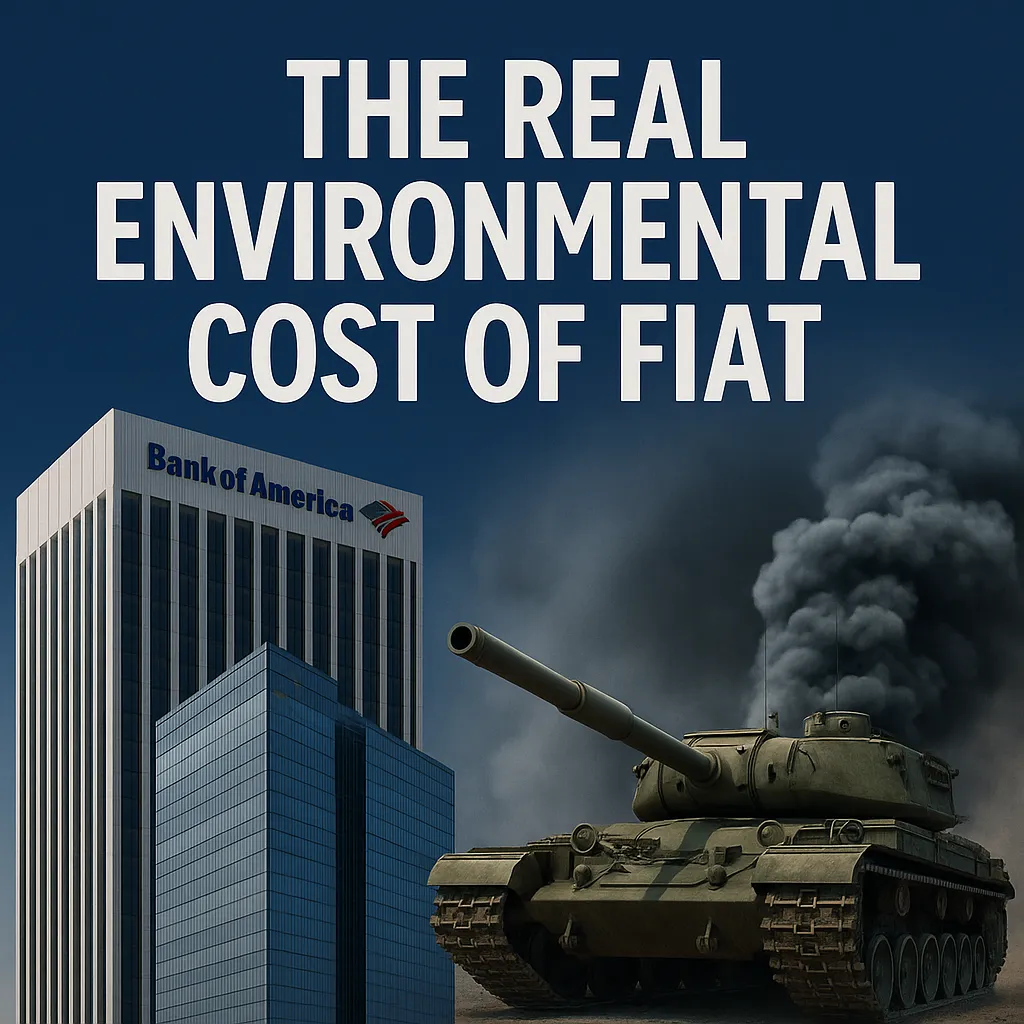
The Real Environmental Cost of Fiat
When critics point fingers at Bitcoin’s energy use, they often forget to look in the mirror. The fiat financial system—the one we all inherited and most still trust—isn’t just broken economically. It’s environmentally toxic.
We’ve been conditioned to think of money as neutral. But money is a tool, and the tool you use shapes the incentives of the system. Fiat money doesn’t just distort economics—it drives environmental destruction on a global scale.
Let’s break it down.
1. The Hidden Footprint of Fiat
Unlike Bitcoin, which has a transparent and auditable energy cost, the fiat system hides its emissions behind a sprawling network of banks, governments, militaries, and extractive industries. Consider just a few components:
Banking Infrastructure: Tens of thousands of skyscrapers, ATMs, server farms, corporate campuses, and office buildings. All require electricity, HVAC systems, security, lighting, and constant upkeep.
Central Banks and Governments: Physical currency printing, armored transport fleets, minting facilities, government agencies, and monetary policy departments—all contribute to carbon output.
The Military-Industrial Complex: Fiat money enables unchecked military spending through debt. The U.S. dollar’s dominance is enforced, in part, by military might—a sector with one of the largest carbon footprints on Earth.
Consumerism and Overproduction: Fiat fuels artificial demand. Inflation discourages saving and encourages excessive consumption. Goods are built to break so you’ll keep buying. Time preferences rise, and planned obsolescence becomes standard. All of this leads to more resource extraction, more energy use, and more waste.
Bitcoin doesn’t require a military. It doesn’t need office buildings. It doesn’t print anything. It simply runs—with full transparency and an incentive to use the cheapest, often cleanest, energy available.
2. Fiat Fuels the Debt Spiral—and the Climate Crisis
Fiat currencies lose purchasing power over time by design. Central banks respond to economic downturns by printing money, which floods markets with liquidity and cheap debt.
But here’s the catch: cheap debt leads to bad decisions.
Mega projects get greenlit without real scrutiny. Speculative industries explode. Fossil fuel subsidies continue. Governments and corporations alike are incentivized to chase short-term gains, not long-term sustainability.
As debt grows, so does the need to inflate it away. This drives more consumption, more extraction, and more emissions. It’s a vicious cycle that’s deeply intertwined with the climate crisis—but rarely called out.
Bitcoin, by contrast, is disinflationary. Its fixed supply encourages saving, not spending. It favors capital discipline, not reckless expansion. That means fewer white elephants and more accountability.
3. Bitcoin’s Energy Isn’t the Problem—Fiat’s Incentives Are
Critics obsess over Bitcoin’s energy use because it’s measurable. But they ignore the fact that much of Bitcoin mining uses renewable, stranded, or wasted energy. Hydroelectric surplus in China, flared gas in Texas, underutilized geothermal in Iceland—these aren’t edge cases. They’re the economic reality of mining.
Why? Because miners go where energy is cheapest—and that often means where it’s cleanest or would otherwise be wasted.
Fiat can’t say the same. Its emissions are woven into everything from luxury bank towers to tanks rolling through oil fields.
If we want a real conversation about sustainability, we need to ask: What system creates the right incentives? Not what system hides its emissions better.
4. Proof-of-Work vs. Proof-of-Waste
Bitcoin’s proof-of-work is often mischaracterized as a bug. It’s not. It’s what makes Bitcoin secure, neutral, and globally verifiable without trusted third parties.
Fiat’s proof-of-stake, by contrast, is enforced through political power, crony capitalism, and military muscle.
Which is more wasteful?
Bitcoin’s footprint is the cost of decentralized consensus. Fiat’s is the cost of centralized control—with environmental damage as a byproduct, not a feature.
Conclusion: Bitcoin Is Cleaner Than Fiat
When viewed holistically, Bitcoin is a cleaner, leaner, and more transparent monetary system than fiat. Its critics mistake visibility for damage. Just because Bitcoin’s energy use is obvious doesn’t mean it’s worse.
Fiat’s hidden environmental toll is the real scandal. We’ve just been too conditioned to notice.
If we’re serious about a sustainable future, it’s time to challenge not just how much energy is used—but what it’s used for. Bitcoin uses energy to build an incorruptible financial foundation. Fiat uses it to prop up a broken, extractive empire.
That’s the real environmental cost. And it’s long past due for a reckoning.



